Business Law Report: English Legal System and Business Law Analysis
VerifiedAdded on 2022/11/28
|8
|2122
|102
Report
AI Summary
This report provides a comprehensive overview of business law, focusing on the English legal system and its various components. It begins with an introduction to business law, differentiating between company-related laws and those regulating business operations. The report then delves into the structure of the English legal system, including the roles of different courts and the doctrine of stare decisis. It examines the sources of law, such as legislation, common law, and European Union law, and details the law-making authority and process in the UK. The report further analyzes the impact of business legislations, including employment law, company law, and contract law, on business performance, highlighting key legislation like the Equality Act, the Company Law Act, and the principles of contract law. The report concludes with a summary of the key findings and a list of references.
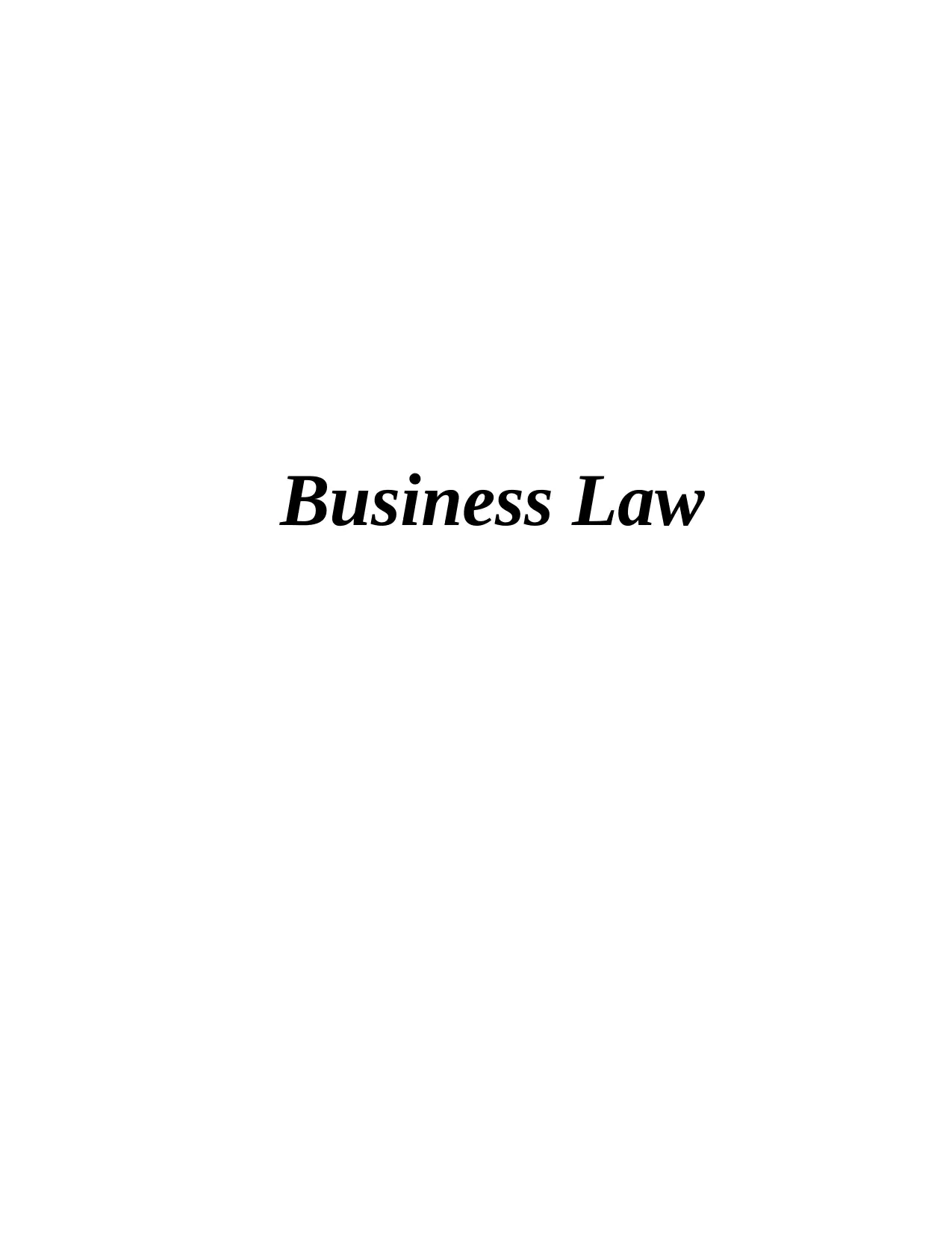
Business Law
Paraphrase This Document
Need a fresh take? Get an instant paraphrase of this document with our AI Paraphraser
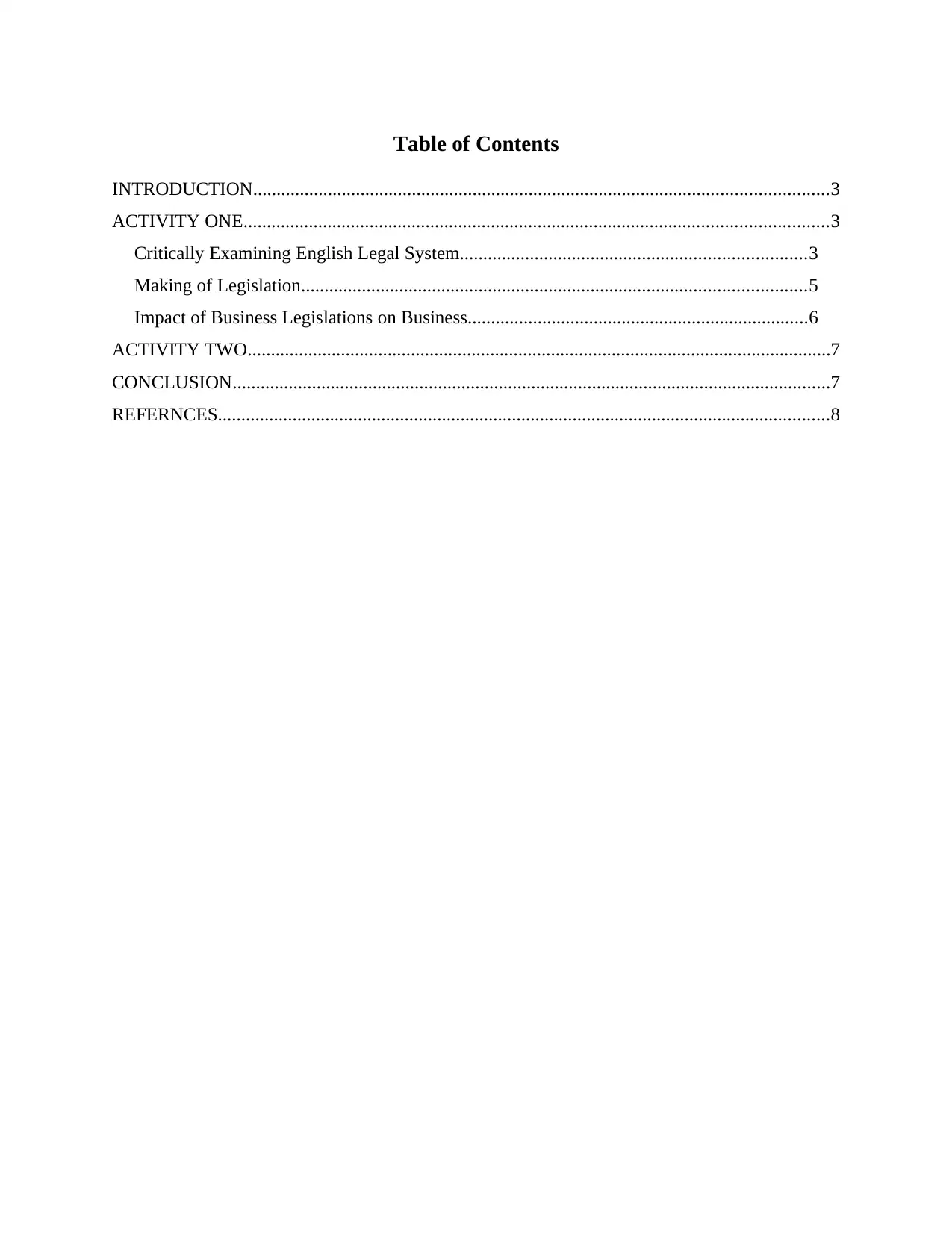
Table of Contents
INTRODUCTION...........................................................................................................................3
ACTIVITY ONE.............................................................................................................................3
Critically Examining English Legal System..........................................................................3
Making of Legislation............................................................................................................5
Impact of Business Legislations on Business.........................................................................6
ACTIVITY TWO.............................................................................................................................7
CONCLUSION................................................................................................................................7
REFERNCES...................................................................................................................................8
INTRODUCTION...........................................................................................................................3
ACTIVITY ONE.............................................................................................................................3
Critically Examining English Legal System..........................................................................3
Making of Legislation............................................................................................................5
Impact of Business Legislations on Business.........................................................................6
ACTIVITY TWO.............................................................................................................................7
CONCLUSION................................................................................................................................7
REFERNCES...................................................................................................................................8
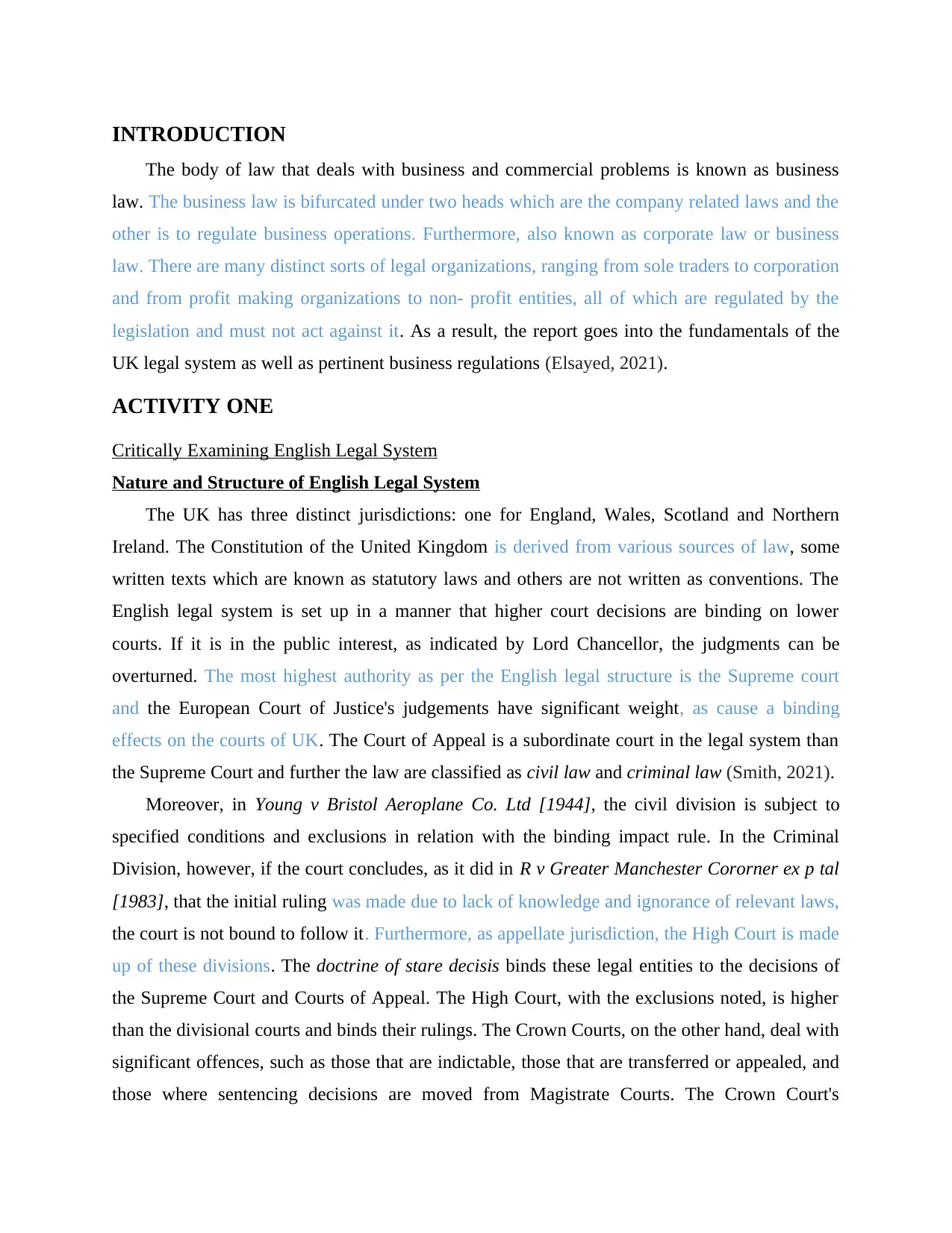
INTRODUCTION
The body of law that deals with business and commercial problems is known as business
law. The business law is bifurcated under two heads which are the company related laws and the
other is to regulate business operations. Furthermore, also known as corporate law or business
law. There are many distinct sorts of legal organizations, ranging from sole traders to corporation
and from profit making organizations to non- profit entities, all of which are regulated by the
legislation and must not act against it. As a result, the report goes into the fundamentals of the
UK legal system as well as pertinent business regulations (Elsayed, 2021).
ACTIVITY ONE
Critically Examining English Legal System
Nature and Structure of English Legal System
The UK has three distinct jurisdictions: one for England, Wales, Scotland and Northern
Ireland. The Constitution of the United Kingdom is derived from various sources of law, some
written texts which are known as statutory laws and others are not written as conventions. The
English legal system is set up in a manner that higher court decisions are binding on lower
courts. If it is in the public interest, as indicated by Lord Chancellor, the judgments can be
overturned. The most highest authority as per the English legal structure is the Supreme court
and the European Court of Justice's judgements have significant weight, as cause a binding
effects on the courts of UK. The Court of Appeal is a subordinate court in the legal system than
the Supreme Court and further the law are classified as civil law and criminal law (Smith, 2021).
Moreover, in Young v Bristol Aeroplane Co. Ltd [1944], the civil division is subject to
specified conditions and exclusions in relation with the binding impact rule. In the Criminal
Division, however, if the court concludes, as it did in R v Greater Manchester Cororner ex p tal
[1983], that the initial ruling was made due to lack of knowledge and ignorance of relevant laws,
the court is not bound to follow it. Furthermore, as appellate jurisdiction, the High Court is made
up of these divisions. The doctrine of stare decisis binds these legal entities to the decisions of
the Supreme Court and Courts of Appeal. The High Court, with the exclusions noted, is higher
than the divisional courts and binds their rulings. The Crown Courts, on the other hand, deal with
significant offences, such as those that are indictable, those that are transferred or appealed, and
those where sentencing decisions are moved from Magistrate Courts. The Crown Court's
The body of law that deals with business and commercial problems is known as business
law. The business law is bifurcated under two heads which are the company related laws and the
other is to regulate business operations. Furthermore, also known as corporate law or business
law. There are many distinct sorts of legal organizations, ranging from sole traders to corporation
and from profit making organizations to non- profit entities, all of which are regulated by the
legislation and must not act against it. As a result, the report goes into the fundamentals of the
UK legal system as well as pertinent business regulations (Elsayed, 2021).
ACTIVITY ONE
Critically Examining English Legal System
Nature and Structure of English Legal System
The UK has three distinct jurisdictions: one for England, Wales, Scotland and Northern
Ireland. The Constitution of the United Kingdom is derived from various sources of law, some
written texts which are known as statutory laws and others are not written as conventions. The
English legal system is set up in a manner that higher court decisions are binding on lower
courts. If it is in the public interest, as indicated by Lord Chancellor, the judgments can be
overturned. The most highest authority as per the English legal structure is the Supreme court
and the European Court of Justice's judgements have significant weight, as cause a binding
effects on the courts of UK. The Court of Appeal is a subordinate court in the legal system than
the Supreme Court and further the law are classified as civil law and criminal law (Smith, 2021).
Moreover, in Young v Bristol Aeroplane Co. Ltd [1944], the civil division is subject to
specified conditions and exclusions in relation with the binding impact rule. In the Criminal
Division, however, if the court concludes, as it did in R v Greater Manchester Cororner ex p tal
[1983], that the initial ruling was made due to lack of knowledge and ignorance of relevant laws,
the court is not bound to follow it. Furthermore, as appellate jurisdiction, the High Court is made
up of these divisions. The doctrine of stare decisis binds these legal entities to the decisions of
the Supreme Court and Courts of Appeal. The High Court, with the exclusions noted, is higher
than the divisional courts and binds their rulings. The Crown Courts, on the other hand, deal with
significant offences, such as those that are indictable, those that are transferred or appealed, and
those where sentencing decisions are moved from Magistrate Courts. The Crown Court's
⊘ This is a preview!⊘
Do you want full access?
Subscribe today to unlock all pages.

Trusted by 1+ million students worldwide
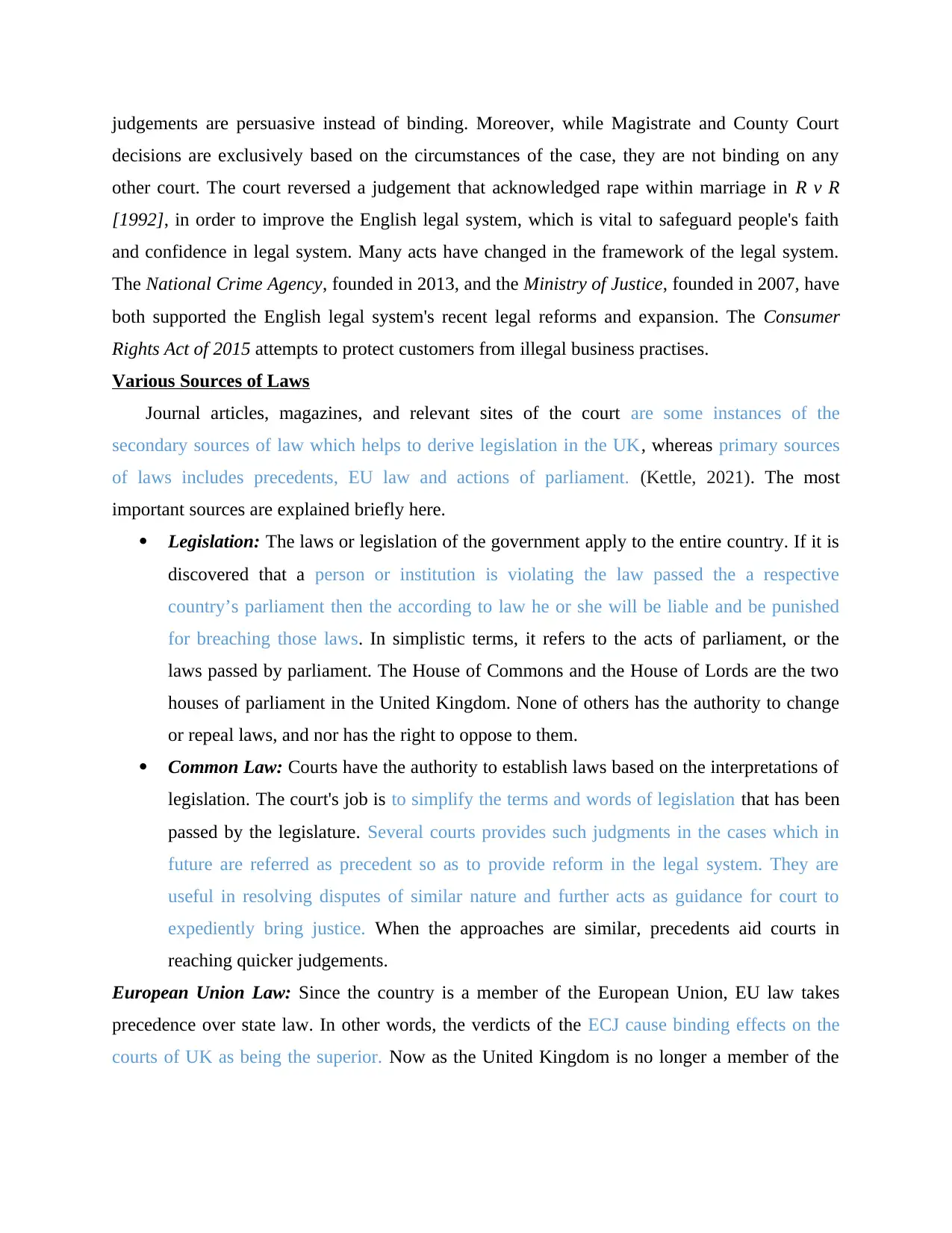
judgements are persuasive instead of binding. Moreover, while Magistrate and County Court
decisions are exclusively based on the circumstances of the case, they are not binding on any
other court. The court reversed a judgement that acknowledged rape within marriage in R v R
[1992], in order to improve the English legal system, which is vital to safeguard people's faith
and confidence in legal system. Many acts have changed in the framework of the legal system.
The National Crime Agency, founded in 2013, and the Ministry of Justice, founded in 2007, have
both supported the English legal system's recent legal reforms and expansion. The Consumer
Rights Act of 2015 attempts to protect customers from illegal business practises.
Various Sources of Laws
Journal articles, magazines, and relevant sites of the court are some instances of the
secondary sources of law which helps to derive legislation in the UK, whereas primary sources
of laws includes precedents, EU law and actions of parliament. (Kettle, 2021). The most
important sources are explained briefly here.
Legislation: The laws or legislation of the government apply to the entire country. If it is
discovered that a person or institution is violating the law passed the a respective
country’s parliament then the according to law he or she will be liable and be punished
for breaching those laws. In simplistic terms, it refers to the acts of parliament, or the
laws passed by parliament. The House of Commons and the House of Lords are the two
houses of parliament in the United Kingdom. None of others has the authority to change
or repeal laws, and nor has the right to oppose to them.
Common Law: Courts have the authority to establish laws based on the interpretations of
legislation. The court's job is to simplify the terms and words of legislation that has been
passed by the legislature. Several courts provides such judgments in the cases which in
future are referred as precedent so as to provide reform in the legal system. They are
useful in resolving disputes of similar nature and further acts as guidance for court to
expediently bring justice. When the approaches are similar, precedents aid courts in
reaching quicker judgements.
European Union Law: Since the country is a member of the European Union, EU law takes
precedence over state law. In other words, the verdicts of the ECJ cause binding effects on the
courts of UK as being the superior. Now as the United Kingdom is no longer a member of the
decisions are exclusively based on the circumstances of the case, they are not binding on any
other court. The court reversed a judgement that acknowledged rape within marriage in R v R
[1992], in order to improve the English legal system, which is vital to safeguard people's faith
and confidence in legal system. Many acts have changed in the framework of the legal system.
The National Crime Agency, founded in 2013, and the Ministry of Justice, founded in 2007, have
both supported the English legal system's recent legal reforms and expansion. The Consumer
Rights Act of 2015 attempts to protect customers from illegal business practises.
Various Sources of Laws
Journal articles, magazines, and relevant sites of the court are some instances of the
secondary sources of law which helps to derive legislation in the UK, whereas primary sources
of laws includes precedents, EU law and actions of parliament. (Kettle, 2021). The most
important sources are explained briefly here.
Legislation: The laws or legislation of the government apply to the entire country. If it is
discovered that a person or institution is violating the law passed the a respective
country’s parliament then the according to law he or she will be liable and be punished
for breaching those laws. In simplistic terms, it refers to the acts of parliament, or the
laws passed by parliament. The House of Commons and the House of Lords are the two
houses of parliament in the United Kingdom. None of others has the authority to change
or repeal laws, and nor has the right to oppose to them.
Common Law: Courts have the authority to establish laws based on the interpretations of
legislation. The court's job is to simplify the terms and words of legislation that has been
passed by the legislature. Several courts provides such judgments in the cases which in
future are referred as precedent so as to provide reform in the legal system. They are
useful in resolving disputes of similar nature and further acts as guidance for court to
expediently bring justice. When the approaches are similar, precedents aid courts in
reaching quicker judgements.
European Union Law: Since the country is a member of the European Union, EU law takes
precedence over state law. In other words, the verdicts of the ECJ cause binding effects on the
courts of UK as being the superior. Now as the United Kingdom is no longer a member of the
Paraphrase This Document
Need a fresh take? Get an instant paraphrase of this document with our AI Paraphraser
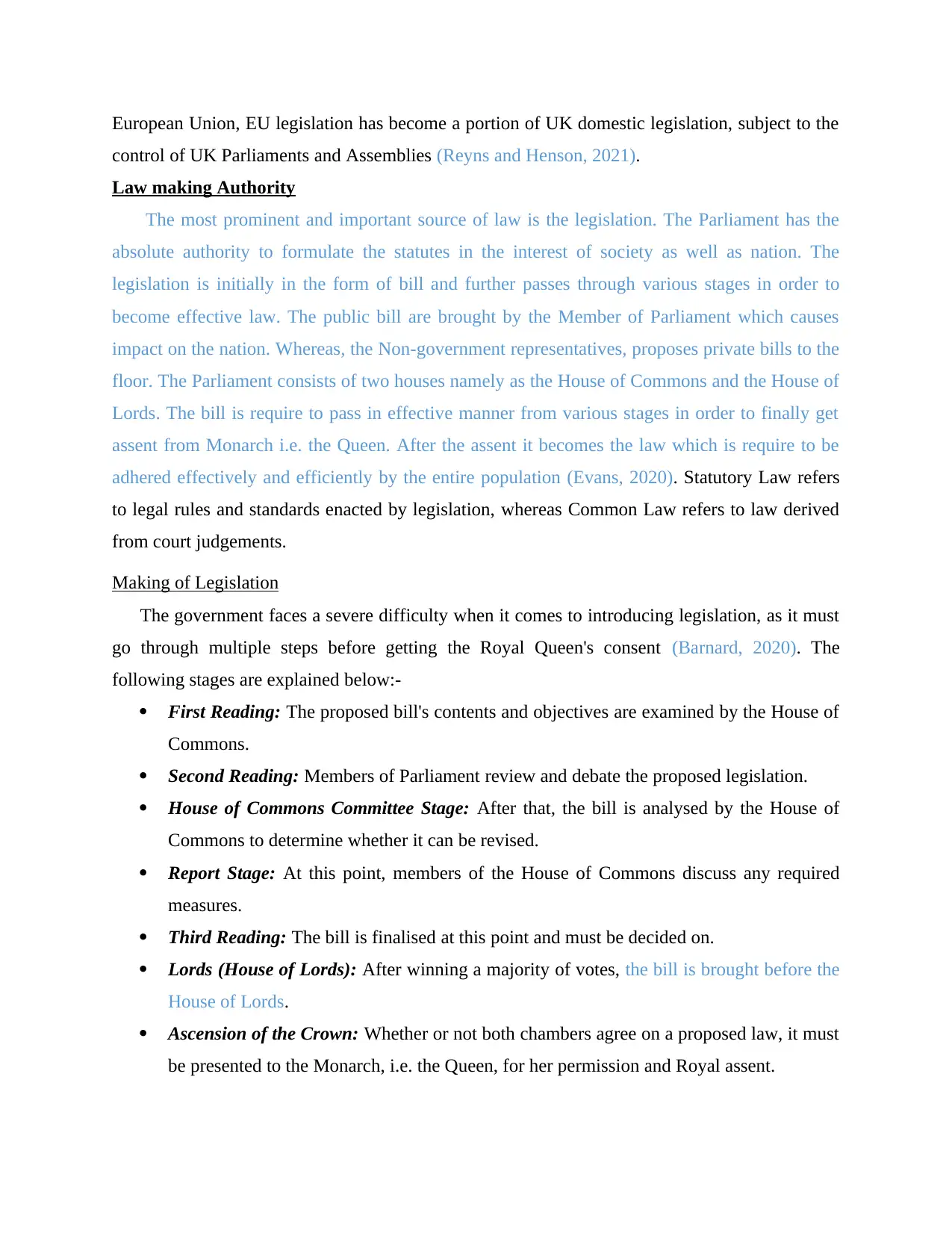
European Union, EU legislation has become a portion of UK domestic legislation, subject to the
control of UK Parliaments and Assemblies (Reyns and Henson, 2021).
Law making Authority
The most prominent and important source of law is the legislation. The Parliament has the
absolute authority to formulate the statutes in the interest of society as well as nation. The
legislation is initially in the form of bill and further passes through various stages in order to
become effective law. The public bill are brought by the Member of Parliament which causes
impact on the nation. Whereas, the Non-government representatives, proposes private bills to the
floor. The Parliament consists of two houses namely as the House of Commons and the House of
Lords. The bill is require to pass in effective manner from various stages in order to finally get
assent from Monarch i.e. the Queen. After the assent it becomes the law which is require to be
adhered effectively and efficiently by the entire population (Evans, 2020). Statutory Law refers
to legal rules and standards enacted by legislation, whereas Common Law refers to law derived
from court judgements.
Making of Legislation
The government faces a severe difficulty when it comes to introducing legislation, as it must
go through multiple steps before getting the Royal Queen's consent (Barnard, 2020). The
following stages are explained below:-
First Reading: The proposed bill's contents and objectives are examined by the House of
Commons.
Second Reading: Members of Parliament review and debate the proposed legislation.
House of Commons Committee Stage: After that, the bill is analysed by the House of
Commons to determine whether it can be revised.
Report Stage: At this point, members of the House of Commons discuss any required
measures.
Third Reading: The bill is finalised at this point and must be decided on.
Lords (House of Lords): After winning a majority of votes, the bill is brought before the
House of Lords.
Ascension of the Crown: Whether or not both chambers agree on a proposed law, it must
be presented to the Monarch, i.e. the Queen, for her permission and Royal assent.
control of UK Parliaments and Assemblies (Reyns and Henson, 2021).
Law making Authority
The most prominent and important source of law is the legislation. The Parliament has the
absolute authority to formulate the statutes in the interest of society as well as nation. The
legislation is initially in the form of bill and further passes through various stages in order to
become effective law. The public bill are brought by the Member of Parliament which causes
impact on the nation. Whereas, the Non-government representatives, proposes private bills to the
floor. The Parliament consists of two houses namely as the House of Commons and the House of
Lords. The bill is require to pass in effective manner from various stages in order to finally get
assent from Monarch i.e. the Queen. After the assent it becomes the law which is require to be
adhered effectively and efficiently by the entire population (Evans, 2020). Statutory Law refers
to legal rules and standards enacted by legislation, whereas Common Law refers to law derived
from court judgements.
Making of Legislation
The government faces a severe difficulty when it comes to introducing legislation, as it must
go through multiple steps before getting the Royal Queen's consent (Barnard, 2020). The
following stages are explained below:-
First Reading: The proposed bill's contents and objectives are examined by the House of
Commons.
Second Reading: Members of Parliament review and debate the proposed legislation.
House of Commons Committee Stage: After that, the bill is analysed by the House of
Commons to determine whether it can be revised.
Report Stage: At this point, members of the House of Commons discuss any required
measures.
Third Reading: The bill is finalised at this point and must be decided on.
Lords (House of Lords): After winning a majority of votes, the bill is brought before the
House of Lords.
Ascension of the Crown: Whether or not both chambers agree on a proposed law, it must
be presented to the Monarch, i.e. the Queen, for her permission and Royal assent.
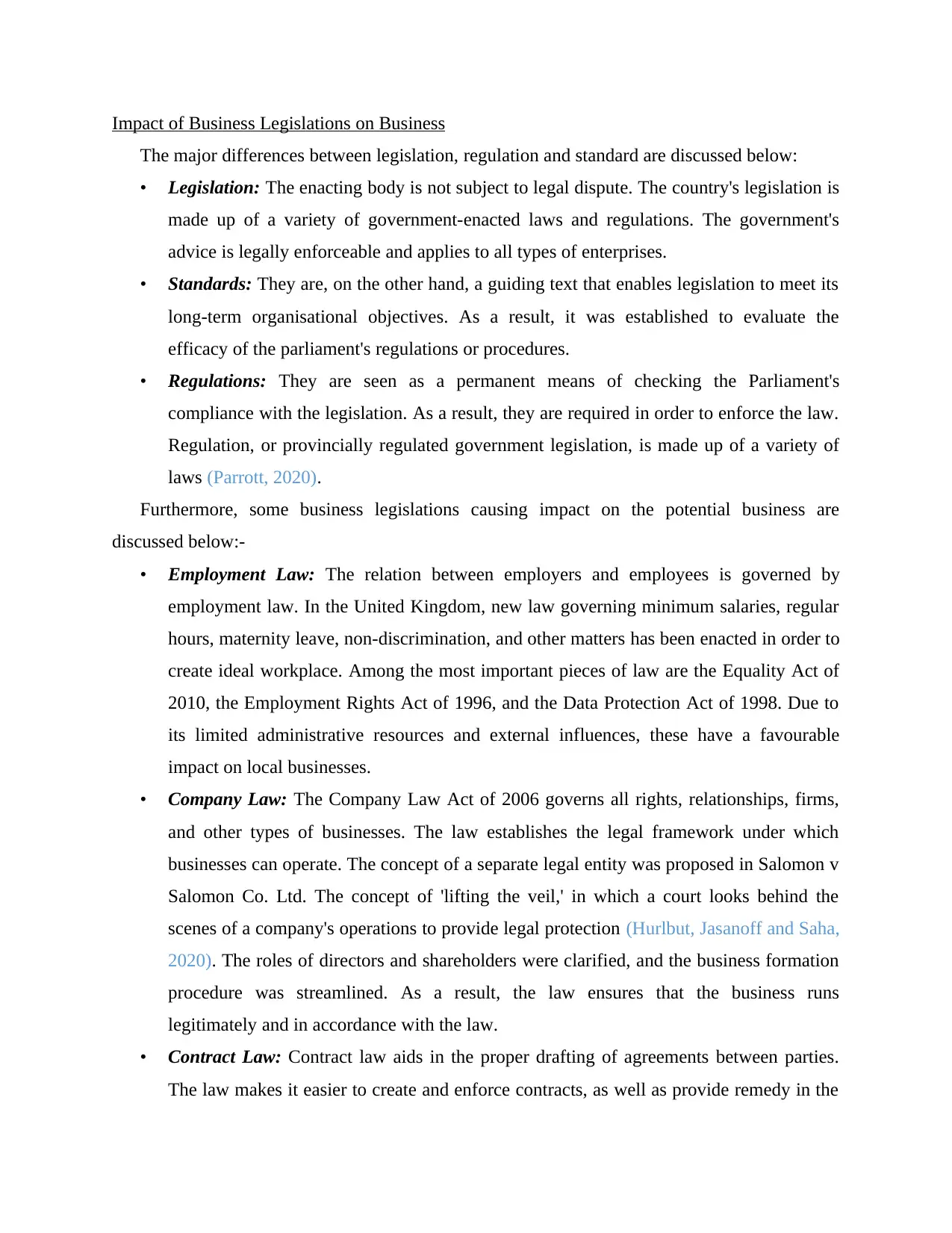
Impact of Business Legislations on Business
The major differences between legislation, regulation and standard are discussed below:
• Legislation: The enacting body is not subject to legal dispute. The country's legislation is
made up of a variety of government-enacted laws and regulations. The government's
advice is legally enforceable and applies to all types of enterprises.
• Standards: They are, on the other hand, a guiding text that enables legislation to meet its
long-term organisational objectives. As a result, it was established to evaluate the
efficacy of the parliament's regulations or procedures.
• Regulations: They are seen as a permanent means of checking the Parliament's
compliance with the legislation. As a result, they are required in order to enforce the law.
Regulation, or provincially regulated government legislation, is made up of a variety of
laws (Parrott, 2020).
Furthermore, some business legislations causing impact on the potential business are
discussed below:-
• Employment Law: The relation between employers and employees is governed by
employment law. In the United Kingdom, new law governing minimum salaries, regular
hours, maternity leave, non-discrimination, and other matters has been enacted in order to
create ideal workplace. Among the most important pieces of law are the Equality Act of
2010, the Employment Rights Act of 1996, and the Data Protection Act of 1998. Due to
its limited administrative resources and external influences, these have a favourable
impact on local businesses.
• Company Law: The Company Law Act of 2006 governs all rights, relationships, firms,
and other types of businesses. The law establishes the legal framework under which
businesses can operate. The concept of a separate legal entity was proposed in Salomon v
Salomon Co. Ltd. The concept of 'lifting the veil,' in which a court looks behind the
scenes of a company's operations to provide legal protection (Hurlbut, Jasanoff and Saha,
2020). The roles of directors and shareholders were clarified, and the business formation
procedure was streamlined. As a result, the law ensures that the business runs
legitimately and in accordance with the law.
• Contract Law: Contract law aids in the proper drafting of agreements between parties.
The law makes it easier to create and enforce contracts, as well as provide remedy in the
The major differences between legislation, regulation and standard are discussed below:
• Legislation: The enacting body is not subject to legal dispute. The country's legislation is
made up of a variety of government-enacted laws and regulations. The government's
advice is legally enforceable and applies to all types of enterprises.
• Standards: They are, on the other hand, a guiding text that enables legislation to meet its
long-term organisational objectives. As a result, it was established to evaluate the
efficacy of the parliament's regulations or procedures.
• Regulations: They are seen as a permanent means of checking the Parliament's
compliance with the legislation. As a result, they are required in order to enforce the law.
Regulation, or provincially regulated government legislation, is made up of a variety of
laws (Parrott, 2020).
Furthermore, some business legislations causing impact on the potential business are
discussed below:-
• Employment Law: The relation between employers and employees is governed by
employment law. In the United Kingdom, new law governing minimum salaries, regular
hours, maternity leave, non-discrimination, and other matters has been enacted in order to
create ideal workplace. Among the most important pieces of law are the Equality Act of
2010, the Employment Rights Act of 1996, and the Data Protection Act of 1998. Due to
its limited administrative resources and external influences, these have a favourable
impact on local businesses.
• Company Law: The Company Law Act of 2006 governs all rights, relationships, firms,
and other types of businesses. The law establishes the legal framework under which
businesses can operate. The concept of a separate legal entity was proposed in Salomon v
Salomon Co. Ltd. The concept of 'lifting the veil,' in which a court looks behind the
scenes of a company's operations to provide legal protection (Hurlbut, Jasanoff and Saha,
2020). The roles of directors and shareholders were clarified, and the business formation
procedure was streamlined. As a result, the law ensures that the business runs
legitimately and in accordance with the law.
• Contract Law: Contract law aids in the proper drafting of agreements between parties.
The law makes it easier to create and enforce contracts, as well as provide remedy in the
⊘ This is a preview!⊘
Do you want full access?
Subscribe today to unlock all pages.

Trusted by 1+ million students worldwide
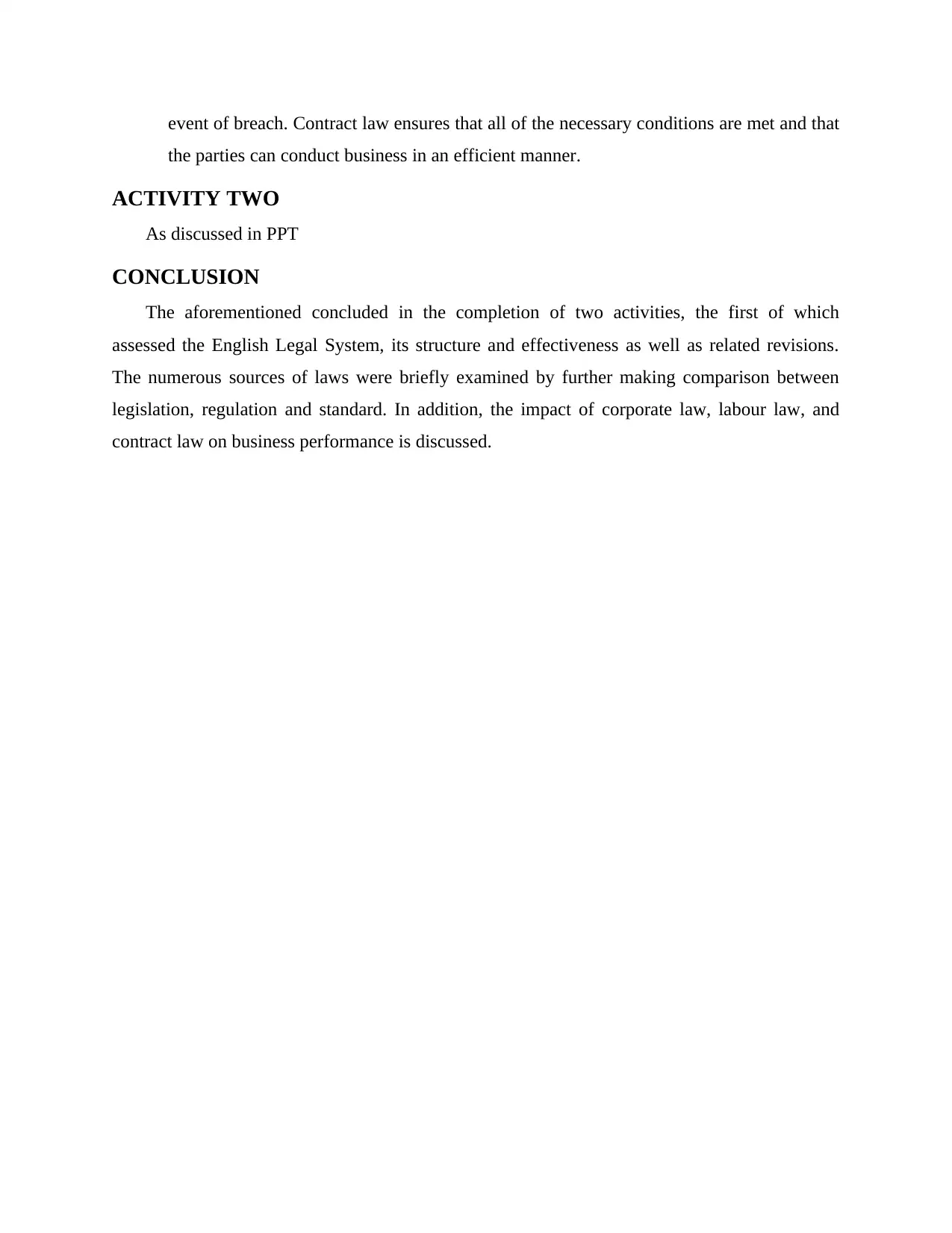
event of breach. Contract law ensures that all of the necessary conditions are met and that
the parties can conduct business in an efficient manner.
ACTIVITY TWO
As discussed in PPT
CONCLUSION
The aforementioned concluded in the completion of two activities, the first of which
assessed the English Legal System, its structure and effectiveness as well as related revisions.
The numerous sources of laws were briefly examined by further making comparison between
legislation, regulation and standard. In addition, the impact of corporate law, labour law, and
contract law on business performance is discussed.
the parties can conduct business in an efficient manner.
ACTIVITY TWO
As discussed in PPT
CONCLUSION
The aforementioned concluded in the completion of two activities, the first of which
assessed the English Legal System, its structure and effectiveness as well as related revisions.
The numerous sources of laws were briefly examined by further making comparison between
legislation, regulation and standard. In addition, the impact of corporate law, labour law, and
contract law on business performance is discussed.
Paraphrase This Document
Need a fresh take? Get an instant paraphrase of this document with our AI Paraphraser
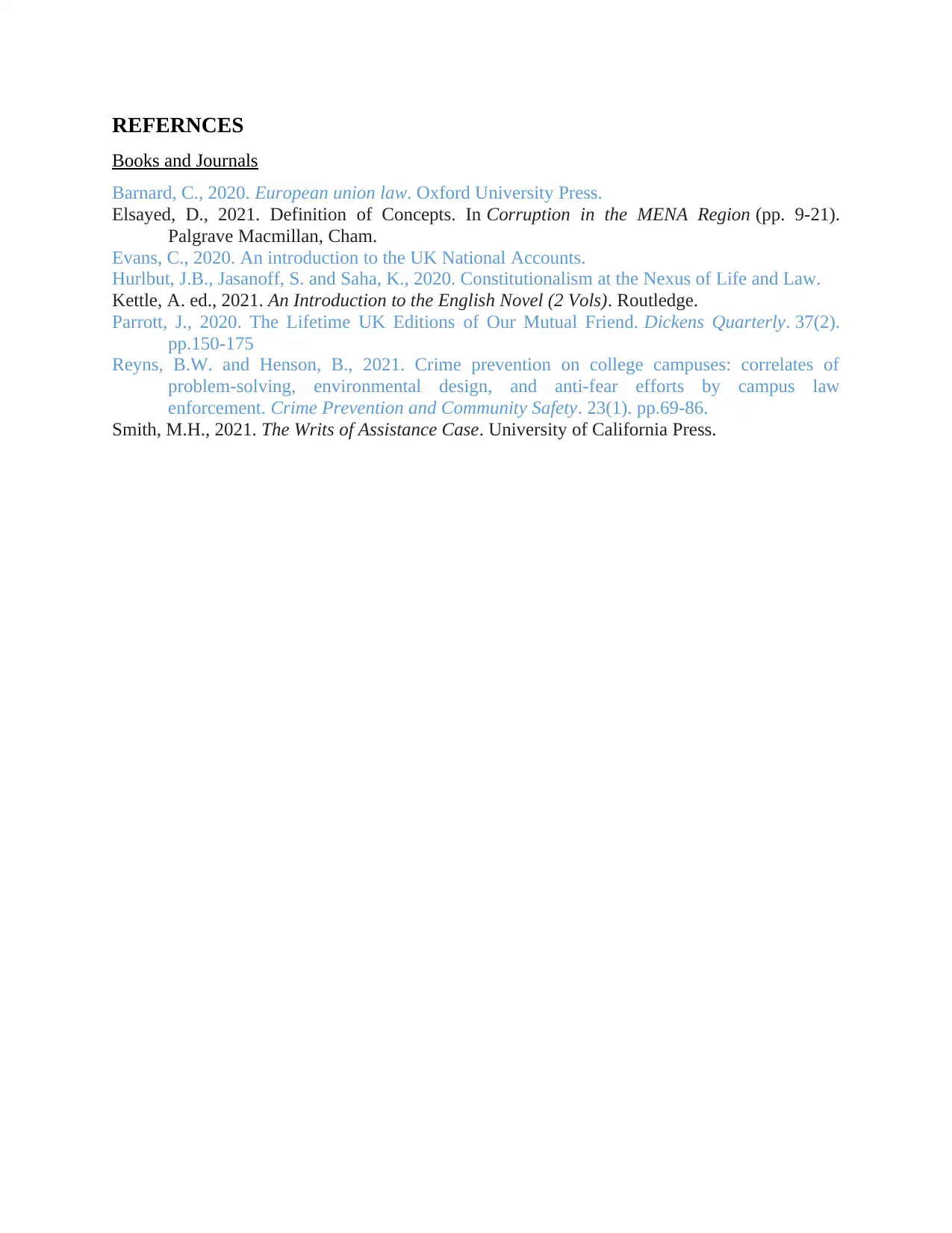
REFERNCES
Books and Journals
Barnard, C., 2020. European union law. Oxford University Press.
Elsayed, D., 2021. Definition of Concepts. In Corruption in the MENA Region (pp. 9-21).
Palgrave Macmillan, Cham.
Evans, C., 2020. An introduction to the UK National Accounts.
Hurlbut, J.B., Jasanoff, S. and Saha, K., 2020. Constitutionalism at the Nexus of Life and Law.
Kettle, A. ed., 2021. An Introduction to the English Novel (2 Vols). Routledge.
Parrott, J., 2020. The Lifetime UK Editions of Our Mutual Friend. Dickens Quarterly. 37(2).
pp.150-175
Reyns, B.W. and Henson, B., 2021. Crime prevention on college campuses: correlates of
problem-solving, environmental design, and anti-fear efforts by campus law
enforcement. Crime Prevention and Community Safety. 23(1). pp.69-86.
Smith, M.H., 2021. The Writs of Assistance Case. University of California Press.
Books and Journals
Barnard, C., 2020. European union law. Oxford University Press.
Elsayed, D., 2021. Definition of Concepts. In Corruption in the MENA Region (pp. 9-21).
Palgrave Macmillan, Cham.
Evans, C., 2020. An introduction to the UK National Accounts.
Hurlbut, J.B., Jasanoff, S. and Saha, K., 2020. Constitutionalism at the Nexus of Life and Law.
Kettle, A. ed., 2021. An Introduction to the English Novel (2 Vols). Routledge.
Parrott, J., 2020. The Lifetime UK Editions of Our Mutual Friend. Dickens Quarterly. 37(2).
pp.150-175
Reyns, B.W. and Henson, B., 2021. Crime prevention on college campuses: correlates of
problem-solving, environmental design, and anti-fear efforts by campus law
enforcement. Crime Prevention and Community Safety. 23(1). pp.69-86.
Smith, M.H., 2021. The Writs of Assistance Case. University of California Press.
1 out of 8
Related Documents
Your All-in-One AI-Powered Toolkit for Academic Success.
+13062052269
info@desklib.com
Available 24*7 on WhatsApp / Email
![[object Object]](/_next/static/media/star-bottom.7253800d.svg)
Unlock your academic potential
Copyright © 2020–2025 A2Z Services. All Rights Reserved. Developed and managed by ZUCOL.





